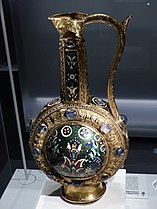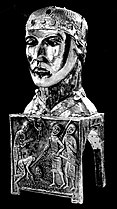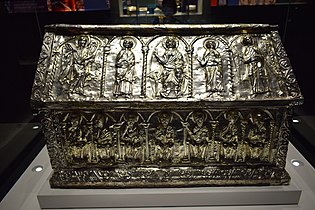Saint-Maurice Abbey
| Saint-Maurice Abbey | |
| Basic data | |
|---|---|
| Country | Switzerland |
| Ecclesiastical province | Immediate |
| Dept | Jean César Scarcella CRSA |
| Vicar General | Roland Jaquenoud CRSA |
| founding | 6th century |
| surface | 100 km² |
| Parishes | 4 (2016 / AP 2017 ) |
| Residents | 7,873 (2016 / AP 2017 ) |
| Catholics | 5,959 (2016 / AP 2017 ) |
| proportion of | 75.7% |
| Religious priest | 34 (2016 / AP 2017 ) |
| Catholics per priest | 175 |
| Friars | 37 (2016 / AP 2017 ) |
| Religious sisters | 34 (2016 / AP 2017 ) |
| rite | Roman rite |
| Liturgical language | French |
| cathedral | Cathédrale abbatiale de Saint-Maurice |
| address | CP 142 CH-1890 Saint-Maurice Valais, Suisse |
| Website | http://www.abbaye-stmaurice.ch/ |
The Abbey of Saint-Maurice ( French Abbaye de Saint-Maurice d'Agaune ; Latin Territorialis Abbatia Sancti Mauritii Agaunensis ) is a monastery of the Augustinian Canons in Saint-Maurice , Canton of Valais , Switzerland . It is considered to be the oldest monastery in the West that has existed without interruption. In 2014/2015 the abbey celebrated its 1500th anniversary.
In addition to the monastery, the abbey is also a territorial abbey with an area of almost 100 square kilometers. It has comprised the parishes of Finhaut, Vernayaz, Salvan and Saint-Maurice / Mex since 1993, and from 1933 onwards it also included the parishes of Choëx and Lavey-Morcles, which in 1993 were added to the diocese of Sitten.
history
Local history
The origins of the abbey go back to a sanctuary that was erected over the grave of Saint Mauritius (German: St. Moritz) and his companions from the Theban Legion , who allegedly suffered martyrdom with him towards the end of the 3rd century AD has been. The sanctuary was at the old Roman military base Agaunum .
Saint Theodor , Bishop of Octodurus (Martigny) , transferred the relics of the martyrs around 380 into the large caves at the foot of the rock gate through which the Rhone leaves the Valais. As a result, Agaunum developed into a Christian pilgrimage site. St. Sigismund , son of the Burgundian king Gundobad , founded the monastery, which still exists today, on September 22, 515, and St. Abbot Ambrosius (516-520) built a new basilica over the original sanctuary . In the 9th century the monks were canons replaced and in 1128 they took over the Rule of St. Augustine .
In the decades after its foundation, the Abbey of Saint-Maurice under Sigismund became the most important abbey in the Kingdom of Burgundy . The characteristic liturgy of laus perennis , the everlasting hymn of praise, practiced there , was an innovation for Western Europe at the time, as it was adopted from the Byzantine Empire . From Saint-Maurice, this practice spread throughout Western Europe. In order to keep the everlasting hymn of praise going, a large number of monks were necessary, which is why Sigismund furnished the monastery richly and sent numerous monks from the rest of the kingdom to it. In 961, the later Emperor Otto I moved the relics of St. Mauritius to the Cathedral in Magdeburg , which dealt a severe blow to the attractiveness of the abbey for pilgrims.
Building history
The oldest foundations in Martolet date from Roman times . The function of the buildings erected with a conspicuously sloping orientation compared to the more recent buildings has not been clarified, nor is the relationship to the ancient spring system further to the west. At the foot of the rock, a small south-facing building was built in which burials took place. A construction commissioned by Bishop Theodor towards the end of the 4th century to bury the bones of the martyrs would be conceivable. Next to it was a rectangular building with an annex on one short side. This building was initially interpreted as the dwelling of a religious community, but investigations from 2001 indicate a first sacred building . These first two buildings were followed by a series of newly built churches and chapels, which were initially built parallel to the rock face.
The foundations of the so-called Sigismund Church, which probably dates from the early 6th century, are archaeologically recorded. In 575 it was destroyed by invading Lombards and subsequently rebuilt. The construction phase from the 7th century, known as Gontran Church, shows a significant increase in the size of the building; The polygonal apse and the entrance that led to the west entrance with a monumental staircase have been preserved . In the 8th century a new complex was built, a basilica , which is associated with the abbots Willicarius and Altheus. It had a choir on each of the two narrow sides . In contrast to the previous buildings, which had been geosted , their crypt was under the west choir. The relics of St. Mauritius were also kept here.
Empress Adelheid , who also paid a visit to the abbey, donated the bell tower at the end of the 10th century, which was built on the site of the east choir and still towers over the monastery today. From the 11th century it served as the entrance to the newly built Romanesque church building. Two chapels were built between this entrance tower and the rock in Gothic times.
In 1148 Pope Eugene III consecrated the new church. In the following centuries, however, the building was repeatedly endangered by rockfalls, including in 1611. Subsequently, from 1614 to 1624 a new church was built, which was rotated by 90 ° compared to the old system, so that the newly built nave runs from north to south, at right angles to the monastery complex. In 1693 a fire devastated numerous buildings of the abbey, which were rebuilt at the beginning of the 18th century. On March 3, 1942, a rock fall destroyed the church tower, the vestibule and the organ. The reconstruction took place from 1946 to 1950 under the direction of the architect Claude Jacottet, the stained glass windows were made by Edmond Bille . In this context, the Romanesque cloister was also restored. On November 30, 1948, the church was opened by Pope Pius XII. for minor Basilica applicable, the consecration took place 1949th
Archaeological exploration and touristic presentation
Excavations on the site of the old church were led by the prior Pierre Bourban (1896-1920) and the Geneva professor Louis Blondel (1944-1945). Further work took place between 1994 and 1996. They brought to light several floors, painted graves and walls that were not recorded in the traditional documentation. From 2001, the previous findings were therefore checked.
The anniversary year of the abbey began on September 21, 2014 with the opening of a tour to visit the cultural heritage site. It leads from the basilica via the archaeological site, the catacombs and the new hall of the monastery treasury to the monastery. "With the help of light panels, interactive screens, models and 3D films, the story of a [...] religious community is told which testifies to a spiritual and cultural activity that is unprecedented in the Christian West". Visitors can see the history and development of the abbey under a 1200 m², translucent roof to protect the ruins.
Monastery treasure
Saint-Maurice is home to one of the richest ecclesiastical treasures in Europe, which was mainly acquired through donations from the faithful. Among other things, it includes valuable vessels such as a piece of sardonyx that dates back to the 1st century BC. And a golden water jug that was given to the abbey by Charlemagne . There is also a golden monstrance and various other objects for cultic use.
A large part of the monastery treasures are the reliquaries and shrines for keeping the relics, such as the head reliquary of Saint Candidus , which was made around 1165. The following shrines should be mentioned:
- the so-called Theuderich shrine from the first half of the 7th century
- the 12th century shrine of Saint Mauritius
- the shrine of the sons of St. Sigismund, also from the 12th century
- the shrine of Abbot Nantelmus, which can be dated to the year 1225 by an inscription on it.
Almost all of the pieces have remained intact despite the repeated destruction of the church buildings and some are still in liturgical use. As part of the anniversary celebrations, the monastery treasure was exhibited in the Louvre in February 2014 .
status
The abbey does not belong to any diocese and enjoys the status of a territorial abbey : the abbot exercises his own jurisdiction over the 68 clerics associated with the monastery and the approximately 6,574 believers on a territory of 9,685 hectares . The Abbot of Saint-Maurice is also the head of the Augustinian Canons Congregation of the same name and a member of the Swiss Bishops' Conference .
Personalities
- Otto Bayard was a student in Saint-Maurice in 1898/99. He is the father of iodine prophylaxis .
- Maurice Tornay studied from 1925 to 1931 at the College of Saint-Maurice Abbey. Tornay was later Augustinian canon, died as a missionary in Tibet to martyrdom and was on 16 May 1993 by Pope John Paul II. Beatified .
See also
- List of Abbots of Saint-Maurice
- Roman Catholic Church in Switzerland
- Swiss Bishops' Conference
- List of Roman Catholic Dioceses
Web links
- Website (german)
- Entry on Territorial Abbey of Saint-Maurice on catholic-hierarchy.org (English)
- Germain Hausmann: Saint-Maurice (VS, monastery). In: Historical Lexicon of Switzerland .
- Abbaye territoriale de Saint-Maurice d'Agaune on the ETHorama platform
- Werner Bloch: Oldest Abbey of the West: The Miracle of Saint-Maurice , article from March 9, 2016 in the series From Religion and Society of Deutschlandfunk
literature
- Lothar Emanuel Kaiser (ed.): The basilica of the Abbey of Saint-Maurice. Kunstverlag Josef Fink, Lindenberg 1998, ISBN 3-931820-71-8 .
- Albrecht Diem: 'Who is Allowed to Pray for the King? Saint-Maurice d'Agaune and the Creation of a Burgundian Identity ', in: Gerda Heydemann and Walter Pohl (eds.), Post-Roman Transitions. Christian and Barbarian Identities in the Early Medieval West , Turnhout: Brepols 2013 (Cultural Encounters in Late Antiquity and the Middle Ages, Vol. 14), pp. 47-88.
Individual evidence
- ↑ Christophe Büchi: 1500 years of praise to God non-stop. In: NZZ . May 23, 2015, accessed September 14, 2016 .
- ↑ Olivier Roduit: Chronique. In: Les Echos de Saint-Maurice 89 (1994), p. 4, online version [1] , accessed on June 16, 2020
- ↑ a b c media orientation «Presentation of the archaeological site“ Cour du Martolet ”in the Abbey of St-Maurice» . Canton of Valais. May 23, 2002. Archived from the original on November 9, 2014. Retrieved September 22, 2014.
- ^ Ernst Tremp : Adelheid. In: Historical Lexicon of Switzerland . May 15, 2001 , accessed February 16, 2018 .
- ↑ Media orientation “Basilica - Archaeological Site - Treasury: New Tour of the Saint-Maurice Abbey” . Abbaye de Saint-Maurice. September 18, 2014. Archived from the original on November 9, 2014. Retrieved on September 22, 2014.
- ↑ On the church treasure: Le trésor de l'Abbaye . Abbaye de Saint-Maurice. Retrieved September 22, 2014.
- ↑ le tresor de l abbaye de saint maurice expose au louvre on rts.ch, accessed on August 24, 2017.
- ↑ Georges Revaz: Nos morts: le docteur Otto Bayard , in: Les Echos de Saint-Maurice , Volume 55, 1957 Abtei Saint-Maurice, pp. 401-403 (PDF)
Coordinates: 46 ° 13 ′ 10 " N , 7 ° 0 ′ 12" E ; CH1903: 566410 / 118760












